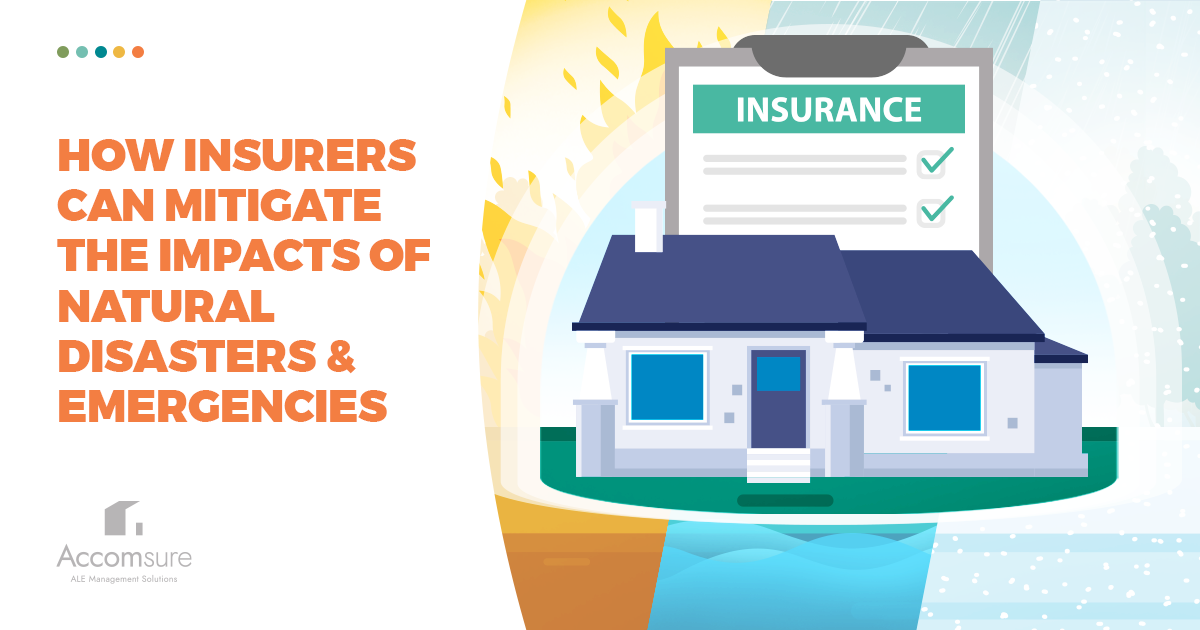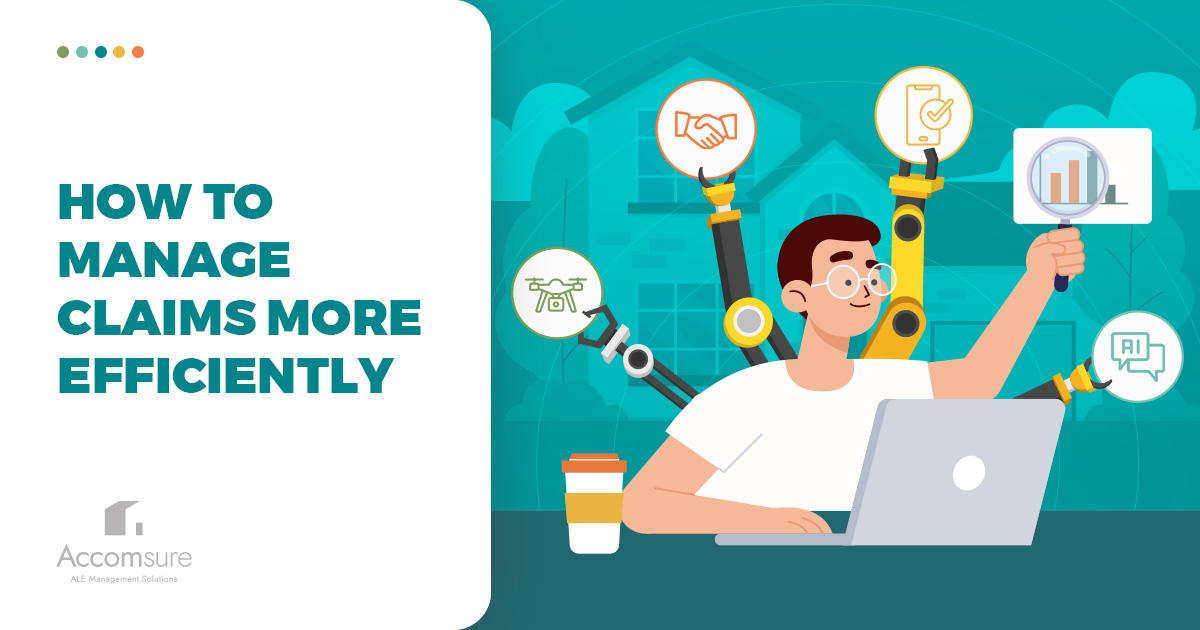Between 2008 and 2022, 480,000 Canadians experienced displacement due to natural disasters (Internal Displacement Monitoring Centre.) Unfortunately, according to Statistics Canada, natural disasters are increasing in severity and frequency.
These statistics highlight the high probability that an increasing number of policyholders will become displaced due to natural disasters in the years to come and signal that adjusters must be ready for an inevitable influx of claims when the next disaster strikes.
The reason adjusters need to be prepared for natural disasters is not only due to the increased workload but also because adjusters play a primary role in facilitating a quick recovery for displaced policyholders impacted by natural disasters.
In this article, we’re outlining six primary ways adjusters and insurance companies can mitigate the impacts of natural disasters, from pre-disaster planning to implementing efficient claims processes during disasters and comprehensive post-emergency support.
1. Be Prepared for Natural Disasters
During a natural disaster, such as a wildfire or flood, adjusters should know emergency response protocols, have practical skills for efficient claims processing, and have access to valuable resources, such as collaborative partnerships with local emergency services and community organizations.
With this information, adjusters can better support policyholders when they need assistance due to displacement. There are two primary ways adjusters and insurance companies can get prepared for the next natural disaster.
Emergency Management Training
Many Canadian provinces have emergency management training to teach participants how to help the community when disaster strikes. The following are the training courses available in a few Canadian provinces:
- British Columbia Emergency Management Training
- Alberta Emergency Management Training
- Saskatchewan Emergency Management Workshops & Exercises
- Manitoba Emergency Management Training
- Ontario Emergency Management Training
Although these training courses aren’t specifically designed for adjusters, they can provide a great deal of valuable information on understanding emergency management and the role of public service officials during a disaster. Going through this training will better equip adjusters to support and answer any questions displaced policyholders may have as they navigate challenging situations.
Build Strong Industry Connections
In addition to emergency management training, adjusters and insurance companies should try to build positive relationships with an array of disaster relief organizations, ALE management companies, and emergency response agencies. These connections will allow adjusters to gain firsthand insight into community-specific challenges so they can provide reliable and valuable resources for displaced policyholders who have nowhere to go.
The Government of Canada website has a long list of various disaster assistance programs that adjusters should have in their arsenal.
2. Leverage Technology

Leveraging technology to mitigate the impacts of natural disasters can help adjusters streamline the claims process and increase customer service.
The following are three ways adjusters and insurance companies can leverage technology to mitigate the impacts of natural disasters.
Use Artificial Intelligence
AI-powered tools and programs can automate and expedite claims processing by quickly analyzing and validating important claims documentation. Using AI will free up time for adjusters to focus on other important aspects of the claim management process.
Here are a few insurance-specific AI tools that adjusters may want to consider using:
- Riskkonnect for claims automation
- Tractable for property assessments
- hostaAI for damage estimations
Use a Mobile App for Emergency Communication
67% of policyholders used smart devices to pay their latest property insurance bills or submit a claim. (J.D. Power)
With over half of policyholders already using their mobile devices for insurance-related processes, insurance companies should consider investing in a mobile app with emergency support and communication options.
With a mobile app, adjusters can provide timely updates, evacuation instructions, and emergency assistance information to enhance overall communication and support during a disaster.
Use Chatbots for Customer Support
Leveraging chatbots during a natural disaster can significantly help adjusters and policyholders alike.
For adjusters, chatbots can manage increased customer service demands during emergencies, like when policyholders ask routine queries. Utilizing chatbots can remove simple communication, allowing adjusters to focus their time and expertise on complex or more urgent claims.
AI chatbots can provide policyholders with real-time information, including claim status, evacuation procedures, or emergency assistance resources. This immediate support can alleviate policyholders’ stress and uncertainty while fostering trust and reliability in the insurance provider’s responsiveness.
3. Ensure Efficient Claim Processing
After a disaster, insurance companies can have dozens to thousands of displaced policyholders turning to them for help with their claims.
To put this into perspective, the following is a list of some of the most expensive natural disasters and the number of policyholders displaced due to each disaster:
- 2021 British Columbia floods: more than 17,700 policyholders displaced (Global Medic)
- 2016 Fort McMurray wildfire: 88,000 policyholders displaced (Government of Canada)
- 1998 Eastern ice storm: 600,000 policyholders displaced (CTV News)
When adjusters have an increase in policyholder claims, the workload can become very stressful, and it can be very challenging to provide the best possible support to all policyholders. Unfortunately, this can create negative customer sentiment and reduce the chances of policyholders continuing their policies with the insurance company.
However, by implementing some of the following claim-processing techniques, adjusters can reduce the chances of negative customer experiences.
Prioritize Urgent Claims
When managing multiple claims, adjusters must identify and prioritize claims based on the urgency and severity of the situation. Ensuring critical cases receive immediate attention will expedite the overall claims processing timeline.
Implement Fast-Track Procedures
Fast-track procedures are streamlined processes designed to expedite the assessment and settlement of insurance claims, specifically in urgent situations, like the aftermath of a severe storm or wildfire.
Insurance companies can implement a fast-track procedure after a severe storm causes displacement for policyholders in a particular area. Rather than determining all of the nitty-gritty details of the claims, insurance companies can establish pre-approved valuation guidelines for common categories, such as personal belongings or furniture.
These guidelines provide adjusters with the maximum reimbursement amounts based on the condition of the items, which will simplify the claim evaluation process.
4. Ensure Active Communication

Maintaining effective communication throughout displaced policyholders’ claim journey is essential for a streamlined and responsive claim process.
Active communication plays a crucial role in fostering policyholder trust and satisfaction, which, in turn, contributes to increased policyholder retention, as consistent and transparent communication strengthens adjuster-policyholder relationships. The following are a few strategies adjusters can implement to ensure active communication with displaced policyholders throughout the claims process.
Diversify Communication Channels
When communicating with adjusters, use a combination of communication channels, such as email, text messages, mobile apps, and social media platforms.
Sharing information through various channels increases the chances of reaching individuals quickly. Additionally, it allows them to access the information from a channel that is most convenient for them, enhancing their user experience.
Implement Automated Notifications
Sending automated notifications can help adjusters maintain active communication with policyholders during natural disasters.
Whether through email, text messages, or a dedicated mobile app, setting up automated notification systems ensures real-time delivery of crucial alerts and updates. Automated notifications can include a variety of information, including:
- Weather warnings
- Evacuation instructions
- Claim status updates
Automated notifications allow adjusters to focus on other claims while still providing policyholders with appropriate information during emergencies.
Emergency Hotlines
When insurance companies offer emergency hotlines, they can create accessible avenues for displaced policyholders to address immediate concerns and seek real-time assistance.
This immediate support is particularly important during emergencies as it instills a sense of trust and support as policyholders navigate the complexities associated with natural disaster recovery.
5. Collaborate With an ALE Management Company

When policyholders become displaced, they often reach out to adjusters for all kinds of support, including claim management, help finding an interim living situation, and more.
However, providing above-and-beyond service is nearly impossible when an adjuster is working on many claims simultaneously due to a natural disaster.
Luckily, ALE management services can step in and support displaced policyholders beyond their claims. Below, we’ve listed some additional benefits of partnering with an ALE management team after a disaster.
Help Policyholders Find Temporary Accommodations
After a disaster, finding appropriate temporary housing can be a struggle for displaced policyholders.
However, ALE management companies, such as Accomsure, can help these displaced policyholders find housing that meets their unique needs. Whether they require pet-friendly housing, wheelchair-friendly housing, or need to be located near accessible transportation, Accomsure will find them the right temporary housing solution.
Save on Claim Costs
ALE management companies, like Accomsure, have a vast network of contacts and are proficient in managing the logistics of the displaced policyholder’s immediate needs. Therefore, they can effortlessly find temporary housing that meets the policyholder’s requirements while staying within the policy limits.
For example, Accomsure worked with a family who lost their rural home to a fire. By leveraging our extensive contact network, we reduced the initial hotel rate by 25% and reduced the claim’s overall temporary accommodation cost by 30%.
Additionally, we ensured the displaced family was relocated to housing with a kitchen so they didn’t have to eat out and accumulate expensive restaurant bills.
6. Post-Emergency Follow-Up
Mitigating the impacts of natural disasters extends beyond the immediate claims processing phase into the post-emergency follow-up.
After the storm has subsided and claims have been near settlement, adjusters should continue to provide ongoing support, which will in turn encourage the policyholder to renew their policy with their insurer.
Additionally, this post-emergency phase offers an opportunity for adjusters to reach out to the displaced policyholders and ask for reviews on how they felt the adjuster supported them throughout the claims process so they can improve their strategies and approaches for future events.
How Accomsure Can Help Adjusters Mitigate Natural Disaster Impacts

Start preparing for the next natural disaster by partnering with Canada’s top ALE management company, Accomsure.
At Accomsure, we’re dedicated to helping displaced policyholders with their immediate needs so adjusters can offload some work and make managing the influx of claims easier.
Contact us today to learn more about how we can support you and your displaced policyholders when the next disaster strikes.




